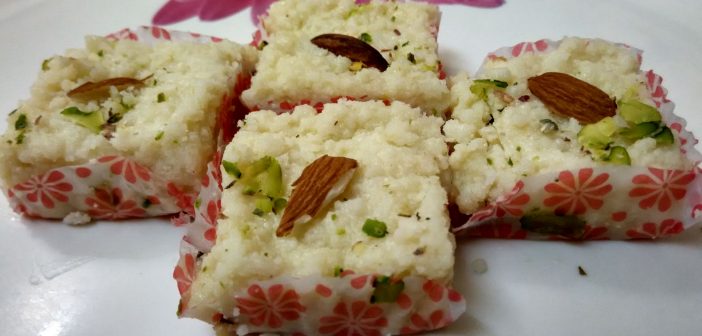India’s culinary landscape boasts a dazzling array of sweets, each region offering its own unique contribution to this sugary symphony. Among these delectable treasures lies Kalakand, a creamy, melt-in-your-mouth fudge that has tantalized taste buds for centuries. This article delves into the fascinating origins, diverse varieties, and irresistible allure of Kalakand.
A Journey Through Time: Tracing Kalakand’s Origins
The exact origin of Kalakand remains shrouded in some mystery, but popular belief places its birthplace in the vibrant city of Alwar, Rajasthan. Legend attributes its creation to a sweet-toothed confectioner named Baba Thakur Das sometime in the 18th century. This connection has earned Kalakand the moniker “Alwar ka Kalakand” (Kalakand of Alwar), a testament to its association with the city.
Another theory suggests that Kalakand might have evolved from similar milk-based confectionaries like khoya, a mainstay in Indian desserts. Over time, the recipe likely underwent refinements, incorporating ingredients like sugar and spices to create the unique texture and flavor profile we know today.
The Essence of Kalakand: Ingredients and Techniques
The essence of Kalakand lies in its simple yet meticulous preparation. The core ingredients are full-cream milk, sugar, and a coagulant like lemon juice or citric acid. Here’s a breakdown of the basic process:
-
Milk Reduction: Full-cream milk is simmered for an extended period, patiently reducing it to a thick, condensed consistency. This step removes excess moisture and concentrates the milk solids, laying the foundation for the fudge-like texture.
-
Sugar Incorporation: Sugar is gradually added to the reduced milk, stirring continuously to ensure it dissolves evenly. This step balances the milk’s richness with sweetness.
-
Coagulation and Setting: A coagulant is introduced, causing the milk proteins to separate from the whey. Careful stirring ensures a smooth texture. The mixture is then cooked further until it reaches the desired consistency – neither too loose nor too stiff.
-
Flavoring and Finishing Touches: While the basic recipe focuses on the interplay between milk and sugar, variations incorporate additional flavors like cardamom, saffron, or chopped nuts for added complexity. Finally, the thickened mixture is poured into a greased tray and allowed to set, transforming into the delectable Kalakand we know and love.
A Celebration of Variety: Exploring Kalakand’s Regional Cousins
Kalakand’s journey across India has resulted in a fascinating array of regional variations, each boasting its own unique twist:
-
Alwar ka Kalakand: The original version, renowned for its rich, milky flavor and soft texture.
-
Mawa Kalakand: This variation from Gujarat and Maharashtra incorporates mawa (khoya) for an extra layer of richness and a slightly grainy texture.
-
Pista Kalakand: Pistachios elevate the dessert in this version, adding a delightful textural contrast and a subtle nuttiness.
-
Chocolate Kalakand: A modern twist incorporates melted chocolate, creating a decadent fusion of flavors.
-
Fruit Kalakand: Chopped fruits like mangoes or figs are added for a burst of freshness and natural sweetness.
-
Singori Kalakand: This unique variation from Madhya Pradesh uses singori flour (made from water chestnuts) instead of milk, offering a gluten-free option.
Beyond the Plate: The Cultural Significance of Kalakand
Kalakand transcends its role as a mere dessert; it is woven into the cultural fabric of India. It graces festive occasions like Diwali, Ganesh Chaturthi, and Raksha Bandhan, signifying sweetness and prosperity. Sharing Kalakand is seen as a gesture of love and well wishes, fostering connection and strengthening bonds.
The Allure of Kalakand: A Sensory Experience
The appeal of Kalakand lies in its simplicity and its ability to awaken the senses. The smooth, melt-in-your-mouth texture is a delight, while the rich flavors of milk and sugar create a comforting warmth on the palate. Subtle hints of cardamom or other spices add a touch of complexity, making each bite a delightful surprise.
A Legacy Enduring: The Future of Kalakand
Kalakand continues to hold a special place in the hearts of Indians. Traditional methods are passed down through generations, ensuring the preservation of this culinary heritage. Modern variations cater to evolving palates, showcasing the adaptability of this timeless dessert. As India’s culinary landscape continues to innovate, Kalakand is sure to evolve alongside it, captivating taste buds for generations to come.
n Conclusion:
From its intriguing origins to its delectable varieties and
cultural significance, Kalakand offers a captivating glimpse into the rich tapestry of Indian sweets. It is a testament to the power of simple ingredients and meticulous techniques, resulting in a dessert that is both luxurious and comforting. Whether enjoyed in its traditional form or in a modern incarnation, Kalakand continues to tantalize taste buds and embody the essence of Indian culinary heritage.
Beyond the Basics: Tips and Tricks for Making Perfect Kalakand
For those inspired to try their hand at making Kalakand, here are some helpful tips:
- Choosing the Right Milk: Opt for full-cream milk with a high fat content for the richest flavor and creamiest texture.
- Patience is Key: Reducing the milk takes time. Resist the urge to rush the process for a smooth and consistent final product.
- Stirring Matters: Continuous stirring prevents scorching and ensures even cooking throughout.
- The Coagulation Conundrum: Adding the coagulant too early can result in a grainy texture. Start with a small amount and observe the setting before adding more.
- Flavor Exploration: Don’t be afraid to experiment! Explore different flavorings like rosewater, saffron, or chopped nuts to personalize your Kalakand.
- Serving Suggestions: Kalakand is best enjoyed at room temperature, sliced into squares or bite-sized pieces. It can be paired with a chilled glass of milk or enjoyed on its own.
A Final Note: A Sweet Connection Across Generations
Kalakand is more than just a dessert; it’s a sweet connection that bridges generations. The act of preparing and sharing this delectable treat fosters a sense of community and tradition. As the aroma of simmering milk fills the kitchen and the creamy Kalakand sets into a delectable treat, one can’t help but appreciate the legacy of this timeless Indian sweet. In a world of fleeting trends, Kalakand’s enduring appeal lies in its simplicity, authenticity, and ability to evoke a sense of nostalgia and joy. So, the next time you encounter this creamy delight, take a moment to savor its rich flavor and appreciate the fascinating journey that brought Kalakand to your plate.






